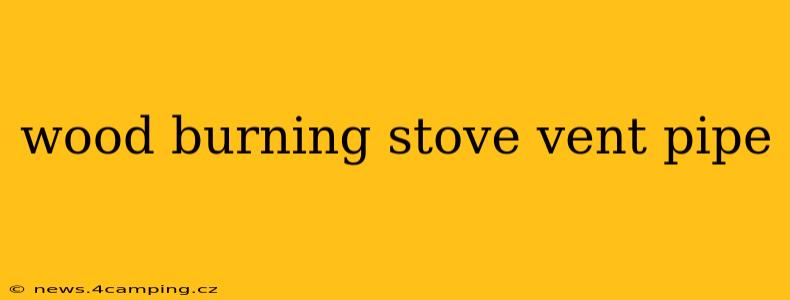Choosing the right vent pipe for your wood burning stove is crucial for safety, efficiency, and longevity. This guide covers everything you need to know about wood burning stove vent pipes, from materials and sizing to installation and maintenance. Ignoring proper venting can lead to serious issues, including carbon monoxide poisoning, house fires, and damage to your stove. Let's delve into the details to ensure you make the right choices.
What are the Different Types of Wood Burning Stove Vent Pipes?
Several materials are used for wood burning stove vent pipes, each with its own advantages and disadvantages:
-
Stainless Steel: This is the most common and generally preferred material. Stainless steel is durable, resistant to corrosion and high temperatures, and relatively easy to install. It's available in various thicknesses, with thicker gauges offering greater durability.
-
Aluminum: Aluminum vent pipes are lighter than stainless steel, making them easier to handle during installation. However, they are less durable and more susceptible to damage from high temperatures and corrosion. They are generally less expensive but may not last as long.
-
Galvanized Steel: While sometimes used, galvanized steel vent pipes are less desirable than stainless steel due to their susceptibility to rust and corrosion. The zinc coating can also degrade over time, releasing potentially harmful fumes.
What Size Vent Pipe Do I Need for My Wood Burning Stove?
The correct size of your vent pipe is critical for efficient and safe operation. The diameter of the vent pipe must match the size of the stove's outlet. This information is typically found in your stove's owner's manual. Using the wrong size can restrict airflow, leading to incomplete combustion, creosote buildup, and potential fire hazards. Always consult your stove's manual for the specific vent pipe diameter requirement.
How Do I Install a Wood Burning Stove Vent Pipe?
Installing a vent pipe correctly is paramount for safety and efficiency. While some homeowners attempt DIY installation, it's often best to hire a qualified professional, especially for complex installations. Incorrect installation can lead to serious safety hazards. A professional installer will ensure the pipe is properly sized, sealed, and securely fastened, adhering to all building codes and safety regulations. Key aspects of installation include:
- Proper Support: The vent pipe needs adequate support to prevent sagging and potential damage.
- Correct Connections: All joints must be properly sealed to prevent leaks and the escape of combustion gases.
- Clearance Requirements: Maintaining sufficient clearance between the pipe and combustible materials is crucial to prevent fires. Check your local building codes for specific requirements.
- Roof Penetration: The pipe's penetration through the roof must be properly sealed and weatherproofed.
How Often Should I Clean My Wood Burning Stove Vent Pipe?
Regular cleaning of your vent pipe is essential for safety and efficiency. Creosote, a highly flammable byproduct of wood combustion, builds up inside the pipe. Excessive creosote buildup can significantly reduce airflow, create a fire hazard, and damage your stove. The frequency of cleaning depends on factors such as the type of wood burned, the frequency of use, and the type of stove. However, a minimum of once a year is recommended, and more frequent cleaning may be necessary for heavy use. A professional chimney sweep can inspect and clean your vent pipe thoroughly.
What are the Signs of a Problem with My Wood Burning Stove Vent Pipe?
Several signs indicate potential problems with your wood burning stove vent pipe:
- Excessive Smoke: Smoke entering the room indicates a problem with the draft, possibly due to a blockage or leak in the vent pipe.
- Soot Buildup: Visible soot buildup inside or outside the pipe suggests incomplete combustion and potential creosote buildup.
- Unusual Noises: Rattling or whistling sounds from the vent pipe may indicate loose connections or obstructions.
- Difficulty Starting or Maintaining a Fire: Problems starting or maintaining a fire could be caused by restricted airflow due to a blocked or improperly sized vent pipe.
Addressing these issues promptly is vital to prevent more serious problems.
Can I Use a Different Type of Pipe Than Recommended by the Manufacturer?
No. Using a vent pipe different from the manufacturer's recommendations could void your warranty and create safety hazards. The manufacturer's specifications are based on thorough testing and ensure the safe and efficient operation of your stove. Deviating from these recommendations is strongly discouraged.
How Much Does a Wood Burning Stove Vent Pipe Cost?
The cost of a wood burning stove vent pipe varies significantly depending on the material, length, diameter, and any additional fittings required. Stainless steel is typically more expensive than aluminum. The overall cost will also depend on whether you install it yourself or hire a professional installer.
This comprehensive guide provides a solid foundation for understanding wood burning stove vent pipes. Remember, safety should always be your top priority. If you are unsure about any aspect of installation or maintenance, consult a qualified professional.
